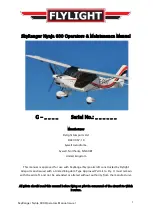
Java Comp 150
Owner’s Manual
Rigging Cables
The main danger with the rigging lies in kinking the cable. This is usually caused by careless rigging and
de-rigging or by over tightening the bolts that attach the tangs to the airframe. (It should be possible to
swivel the tangs with light thumb pressure.) Once a cable has a kink the strands are damaged and
replacement is the only cure. The side cables are particularly important and should receive a frequent
detailed inspection. Check for cable damage along the length but the main failure area lies immediately
adjacent to the swaged fitting. Look carefully for signs of strand fracture at this position. Corrosion shows
itself as a white powdery deposit. Corrosion cannot be cured and the only answer, again, is replacement.
Even apparently undamaged rigging wires should be replaced every 200 hours.
Cross tube tensioner
The stitching on the cross tube tensioner is easy to see and should be inspected frequently. The rest of the
tensioner strop is hidden in the sail and keel pocket so that any damage is more difficult to see. Thus do
take time to inspect this thoroughly, particularly around the VB. Pulleys and the cross tube centre junction
leveller. If any damage to the strop is found (fraying, abrasions, cuts or wear to the stitching) the strop
should be changed before flying.
Wing fabric maintenance
Any cuts or tears at critical areas such as the trailing edge, sail fixing points or similar high load areas,
must be repaired at either the Avian factory or an Avian approved workshop. Small damage to panels,
leading edge covers etc., can be repaired with proprietary self adhesive tape. We define small damage as
abraded holes no more than 10mm diameter and small cuts no longer than 15mm. Anything larger should
be inspected by Avian approved personnel.
Stitching Damage
Thread damage never gets better and eventually runs. If you abrade a seam or damage the stitching in any
way, have the damage repaired before it gets worse. Small, non load-bearing areas can often be repaired in
situ by the tedious but effective method of hand sewing back through the original stitch holes. Use a needle
and only the correct thread: available from Avian or a good sail maker.
Wing fabric cleaning
It is, without doubt, better to keep the wing clean than to try and clean it. Some dirt never comes off
completely. With a new glider avoid getting it dirty in the first place by careful rigging and de-rigging. If
you decide you do need to wash your wing, then select a dry day and have access to a good hose and clean
water supply. Never use bleaches, strong soaps or detergents. The soap residue can react with ultra violet
light and degrade the fabric. We recommend a very mild liquid soap (washing-up liquid) and a soft
sponge. Gently wash the fully rigged wing, frequently hosing clean. Copious amounts of clean water will
not harm the wing and can be very beneficial in removing sand and grit which may get trapped inside the
sail. (Usually in the nose or wing tip areas.) Removing stains from stitching is difficult. Resist the
temptation of scrubbing with a stiff brush as it might do more harm than good. Ensure that the wing is
completely dry before de-rigging and storing.
18
Summary of Contents for JAVA COMP 150 Dacron
Page 27: ...Java Comp 150 Owner s Manual Appendix ASSEMBLY DRAWINGS NOSE ASSEMBLY 27...
Page 28: ...Java Comp 150 Owner s Manual 28...
Page 29: ...Java Comp 150 Owner s Manual CROSS TUBE LEADING EDGE JUNCTION 29...
Page 30: ...Java Comp 150 Owner s Manual 30...
Page 32: ...Java Comp 150 Owner s Manual VARIABLE BILLOW VB OR VARIABLE GEOMETRY VG 32...
Page 33: ...Java Comp 150 Owner s Manual Appendix CHECKING WASHOUT GLIDER MINIMUM REQUIREMENTS 33...
















































